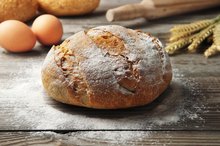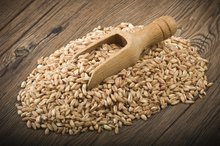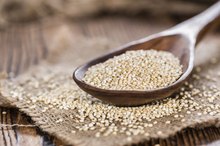What does fact checked mean?
At Healthfully, we strive to deliver objective content that is accurate and up-to-date. Our team periodically reviews articles in order to ensure content quality. The sources cited below consist of evidence from peer-reviewed journals, prominent medical organizations, academic associations, and government data.
The information contained on this site is for informational purposes only, and should not be used as a substitute for the advice of a professional health care provider. Please check with the appropriate physician regarding health questions and concerns. Although we strive to deliver accurate and up-to-date information, no guarantee to that effect is made.
A bagel with cream cheese or peanut butter and jelly can serve as a convenient breakfast food for people on the go, and loading ham and cheese on a bagel provides a new twist to a traditional sandwich. Despite the bagel's convenience and versatility, however, it has a high glycemic index, which means it can significantly raise your blood sugar levels.
Understanding the Glycemic Index
The glycemic index of any type of food refers to how it affects your blood sugar levels. Your body breaks down high-glycemic index foods quickly, which results in a rapid spike in your blood sugar. Foods that rank lower on this index break down slower, resulting in a more steady increase in your blood sugar. Glucose has a glycemic index of 100, and foods with a glycemic index of 70 to 100 are high 3. Those with a glycemic index between 50 and 70 are moderate, and below 50 is low.
- The glycemic index of any type of food refers to how it affects your blood sugar levels.
- Your body breaks down high-glycemic index foods quickly, which results in a rapid spike in your blood sugar.
Bagels Have a High Glycemic Index
Glycemic Index for Grains
Learn More
White bagels have a glycemic index of 72, according to Harvard Health Publications 3. This ranking puts bagels on the low end of what's considered a high glycemic index. Other bread products such as white bread, baguette and waffles also have a glycemic index of at least 70.
Avoid High-Glycemic Index Foods
Even if you enjoy the taste of a bagel, it's best to limit your consumption of all foods with a high glycemic index. The raised blood sugar you experience by consistently eating foods high on this index can eventually lead to a multitude of health problems, including weight gain and Type 2 diabetes. A healthy approach is to limit your consumption of white products, such as:
- bagels
- breads
- pasta
- potatoes
- to no more than 20 percent of your total diet
Look for Healthier Alternatives
Foods That Cause Fatigue
Learn More
When you have a craving for a bread product, opt for a bagel or other type of item that has a medium or low glycemic index. In general, products made from whole wheat, rye or pumpernickel have a lower glycemic index that foods made with white flour. Pumpernickel bread, for example, has a glycemic index of 56, which puts it in the moderate range.
Related Articles
References
- University of Wisconsin School of Medicine and Public Health: Glycemic Index & Glycemic Load
- Canadian Living: The GI Diet Made Easy
- Harvard Health Publications: Glycemic Index and Glycemic Load for 100+ Foods
- American Diabetes Association: Glycemic Index and Diabetes
- Ojo O, Ojo OO, Adebowale F, Wang XH. The effect of dietary glycaemic index on glycaemia in patients with type 2 diabetes: A systematic review and meta-analysis of randomized controlled trials. Nutrients. 2018;10(3):373. Published 2018 Mar 19. doi:10.3390/nu10030373
- Search for the Glycemic Index. The University of Sydney
- Zeevi D, Korem T, Zmora N, et al. Personalized Nutrition by Prediction of Glycemic Responses. Cell. 2015;163(5):1079-1094. doi:10.1016/j.cell.2015.11.001+
- Sacks FM, Carey VJ, Anderson CA, et al. Effects of high vs low glycemic index of dietary carbohydrate on cardiovascular disease risk factors and insulin sensitivity: the OmniCarb randomized clinical trial. JAMA. 2014;312(23):2531-41. doi:10.1001/jama.2014.16658.
- Vega-lópez S, Venn BJ, Slavin JL. Relevance of the Glycemic Index and Glycemic Load for Body Weight, Diabetes, and Cardiovascular Disease. Nutrients. 2018;10(10). doi:10.3390/nu10101361
- Glycemic Index Database. University of Sydney. Updated October 13, 2020
- Eleazu C. O. (2016). The concept of low glycemic index and glycemic load foods as panacea for type 2 diabetes mellitus; prospects, challenges and solutions. African health sciences, 16(2), 468–479. doi:10.4314/ahs.v16i2.15
- Foster-Powell, Kaye, Holt, Susanna and Brand-Miller, Janette. "International table of glycemic index and glycemic load values: 2002." American Journal of Clinical Nutrition. 76,:1: 5-56 (2002).
- International Carbohydrate Quality Consortium, Jenkins, D. J., Willett, W. C., Astrup, A., Augustin, L. S., Baer-Sinnott, S., … Wolever, T. M. (2014). Glycaemic index: did Health Canada get it wrong? Position from the International Carbohydrate Quality Consortium (ICQC). The British journal of nutrition, 111(2), 380–382. doi:10.1017/S0007114513003905
- Leroux, MarcusFoster-Powell, Kaye, Holt, Susanna and Brand-Miller, Janette. "International Table of Glycemic Index and Glycemic Load Values: 2002." American Journal of Clinical Nutrition. Vol. 76, No. 1, 5-56, (2002).
- Lui, S., Willett, WC, et al. "A prospective study of dietary glycemic load, carbohydrate intake, and risk of coronary heart disease in US women.." American Journal of Clinical Nutrition. 71(6):1455-61. (2001).
- Mayer-Davis, E.J., Dhawan, A et al. "Towards understanding of glycaemic index and glycaemic load in habitual diet: associations with measures of glycaemia in the Insulin Resistance Atherosclerosis Study.." British Nutrition Journal. 95(2):397-405. (2006).
- Sacks, F. M., Carey, V. J., Anderson, C. A., Miller, E. R., 3rd, Copeland, T., Charleston, J., … Appel, L. J. (2014). Effects of high vs low glycemic index of dietary carbohydrate on cardiovascular disease risk factors and insulin sensitivity: the OmniCarb randomized clinical trial. JAMA, 312(23), 2531–2541. doi:10.1001/jama.2014.16658
- Salmeron, J, Manson, JE, et al. "Dietary fiber, glycemic load, and risk of non-insulin-dependent diabetes mellitus in women.." Journal of the American Medical Association. 12;277(6):472-7. (1997).
- Vega-López, S., Venn, B., & Slavin, J. (2018). Relevance of the Glycemic Index and Glycemic Load for Body Weight, Diabetes, and Cardiovascular Disease. Nutrients, 10(10), 1361. doi:10.3390/nu10101361
- Zeevi, D. Korem N. et al. Personalized Nutrition by Prediction of Glycemic ResponsesCell. 163:(5):1079-94. November 2015.
Writer Bio
Toronto-based journalist William McCoy has been writing since 1997, specializing in topics such as sports, nutrition and health. He serves as the Studio's sports and recreation section expert. McCoy is a journalism graduate of Ryerson University.









